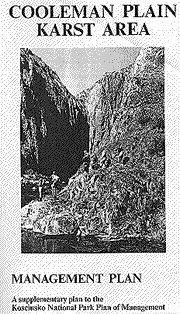Ecosystems at Risk: Limestone caves
8a. Management: Catchment
Why Protect Cave Ecosystems?
- Biodiversity Value: Caves contain species of animals which are rare and occur nowhere else. Many species are endemic to particular caves because caves are a bit like islands, they are not connected and are surrounded by habitats hostile to cave animals so cave animals have difficulty moving from one cave to another. The maintenance of genetic diversity is an important reason for protecting caves.
- Intinsic Value: People value the spectacular formations found in caves. It is a special experience to people when they enter caves, we give caves a high intrinsic value.
- Utility Value: Tourism is an important industry.
- Heritage Value: Limestone caves are a part of our natural heritage. They are found nowhere else and we only have a small number of caves.
- Natural Change: We need to protect caves from human disturbance.
Both the cave formations and their ecosystems are very fragile and easily
damaged by people.
Legislation
 Limestone
caves are uncommon in Australia and government has protected many through
legislation such as the NP&WS Act and the Environmental Planning and
Assessment Act. The Yarrangobilly Caves are in Kosciuszko National Park.
Government legislation states that the National Parks and Wildlife Service
(NPWS) is responsible for protecting the caves but at the same time allow
appropriate use that does not conflict with the preservation of the caves.
To achieve this goal the NPWS are required to have a management plan which
outlines their management strategies. Two main areas need to be considered,
management of the individual caves and management of the whole catchment
above the caves.
Limestone
caves are uncommon in Australia and government has protected many through
legislation such as the NP&WS Act and the Environmental Planning and
Assessment Act. The Yarrangobilly Caves are in Kosciuszko National Park.
Government legislation states that the National Parks and Wildlife Service
(NPWS) is responsible for protecting the caves but at the same time allow
appropriate use that does not conflict with the preservation of the caves.
To achieve this goal the NPWS are required to have a management plan which
outlines their management strategies. Two main areas need to be considered,
management of the individual caves and management of the whole catchment
above the caves.
Catchment Management
Catchments and caves are linked by the flow of water, surface water will
flow or percolate underground and any pollutants or eroded soil transported
by surface streams may be carried into caves. Human changes to the cave
catchment which impact on the water cycle will impact on the caves. This
includes the clearing of vegetation, diversion of streams for irrigation,
the building of roads which change the flow of water with roadside drainage
channels, pollutants from vehicles using roads or fertilizers and herbicides
from agricultural activities which can endanger cave ecosystems.
Catchment Management Practices in the Yarrangobilly area include:
- not allowing camping near the caves;
- retaining the existing buildings and infrastructure of car parks, picnic areas and toilets due to their historic and recreational value;
- working towards minimising the impact of infrastructure on the caves;
- replacement of the pine plantation with the original eucalypt woodland.
Cooleman Plain Management Unit (a karst area near
Yarrangobilly.)
‘Management of the Cooleman Plain area will take into account the vulnerability
of the caves to disturbance, the complex drainage network of the caves
and karst area, the sensitivity of the soils and plant communities to
damage, the outstanding value of the Aboriginal sites and historic places
(Cooleman Homestead) and the desire of considerable numbers of people
to use the area for recreation.' In this area there are a number of separate
features on which we place values which make management a complex task.
Management objectives/tasks could include:
- protecting the caves, each cave is classified for management purposes;
- an interpretive (educational) program to provide visitors with an awareness of the caves;
- a priority list of management works required to protect or rehabilitate the site;
- a new camping area has been provided near the caves but outside of their catchment because of the disturbance caused by the present campsite close to the caves (toilets, erosion, vegetation disturbance)
- replacing present car access with walking tracks and the rehabilitation of the present car park.
| cave management |